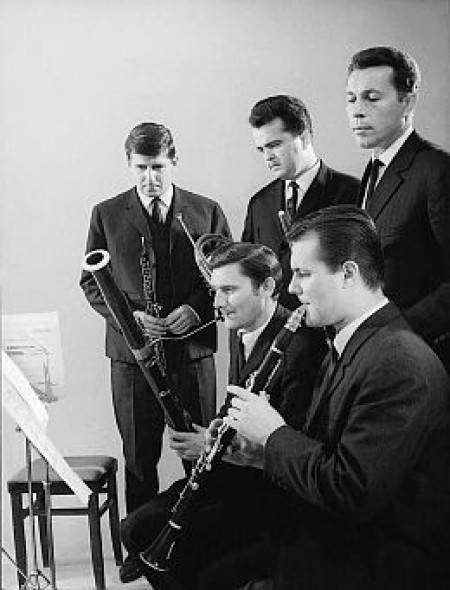
The Hungarian Wind Quintet was founded in 1961 by members of a new, talented and highly trained generation of wind players. Their predecessor and example was the successful Budapest Wind Quintet.
Péter Pongrácz, Béla Kovács and Tibor Fülemile had already worked together a great deal at the chamber music classes at the Academy, playing works from the most diverse periods and styles, from Mozart to the contemporary composers.
They signed contracts with the Opera House orchestra together, and soon afterwards founded the Hungarian Wind Quintet with two young musicians, a flautist and a horn player – Attila Lajos and Ferenc Tarjáni – of the Radio Orchestra.
A few months later they were already appearing abroad, and in 1962 the Quintet won second place at the Geneva International Music Competition. Of the eighteen quintets appearing in the competition, their average age was the youngest, and despite the fact that they came only second, the critics celebrated them, talking about their brilliant technique and profound musicality, which made it possible for them to gain a greater success with Jean Francaix's Wind Quintet, learned with the help of András Mihály, than the ensemble coached by the composer himself did.
Three years later they achieved victory in Budapest, beating the Wind Quintet of the Berlin State Opera. By that time seven excellent wind quintets demonstrated the fact that Hungarian wind culture was advancing apace. Their competition productions were characterised by ease, elegance, suppleness, flexible rhythm and richness of tone, which made it almost inevitable that they should win almost irrespective of the rivals.
The competition prizes and the high standard of their work gained them the Liszt Prize in 1967, and they received many invitations from abroad. The quintet earned great success wherever they performed – demonstrating the truth of the claim by famous experts: wind quintets can only be formed from musicians who could also win individually international prizes with their instruments. The members of the quintet must preserve their artistic personality; this, however, must be supplemented by years of playing together and joint professional thinking in order to achieve the high standard of chamber music playing of which this ensemble is capable of.
Besides cultivating the classic repertoire, the Hungarian Wind Quartet has always paid special attention to contemporary Hungarian music, undertaking to perform and popularise new works. Many reviews attest to their "disarming technical skill", their ease and knowledge of styles. The critic emphasised also in connection with the premier of István Láng's Third Wind Quintet that "a significant contributory factor to the success of this light-contoured, concisely formulated work was the seismograph-like sensibility and, not least, the instrumental virtuosity of the Hungarian Wind Quintet." In connection with the performance of a Janacek work, the specialist music journal, Muzsika wrote: "On this occasion, too, as so many times before, if took the playing of born musicians to discover the true values behind the individuality of a less widely popular composer". (Antal Boronkay)
Those interested can ascertain all this with the help of recordings. In the recording made of the chamber works of four Hungarian composers (Attila Bozay, Emil Petrovics, István Láng and Frigyes Hidas), composed between 1962 and 1969, everything that the five outstanding musicians – the Hungarian Wind Quintet – want and can say about music is expressed in classical forms, in movements built on sound effects, satirical dance caricatures, entertaining light music and jazz rhythms.
A. T.


